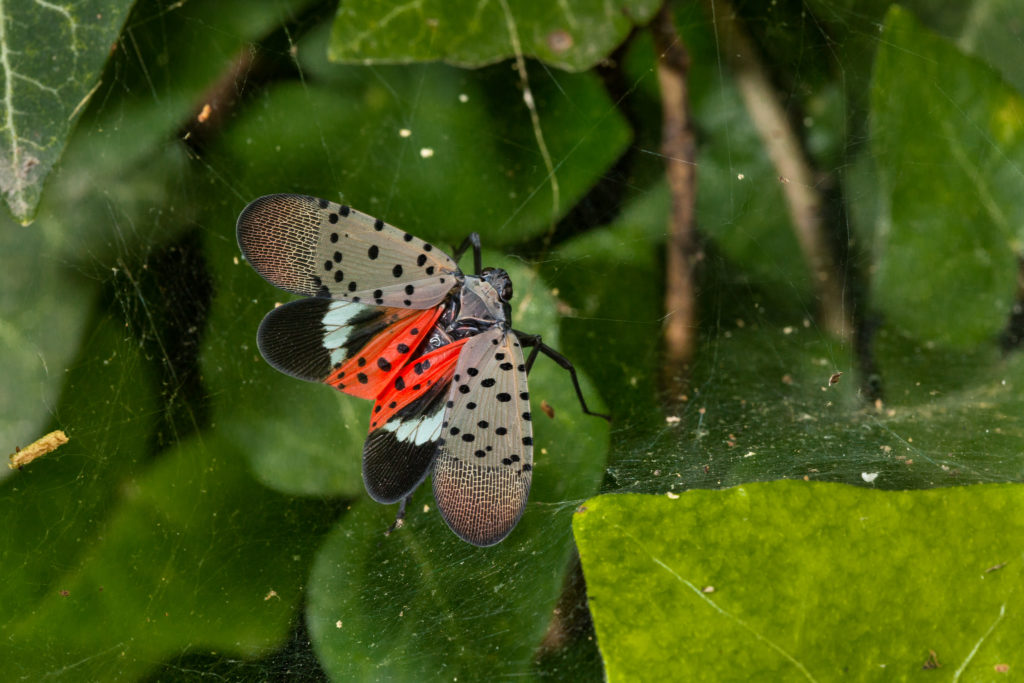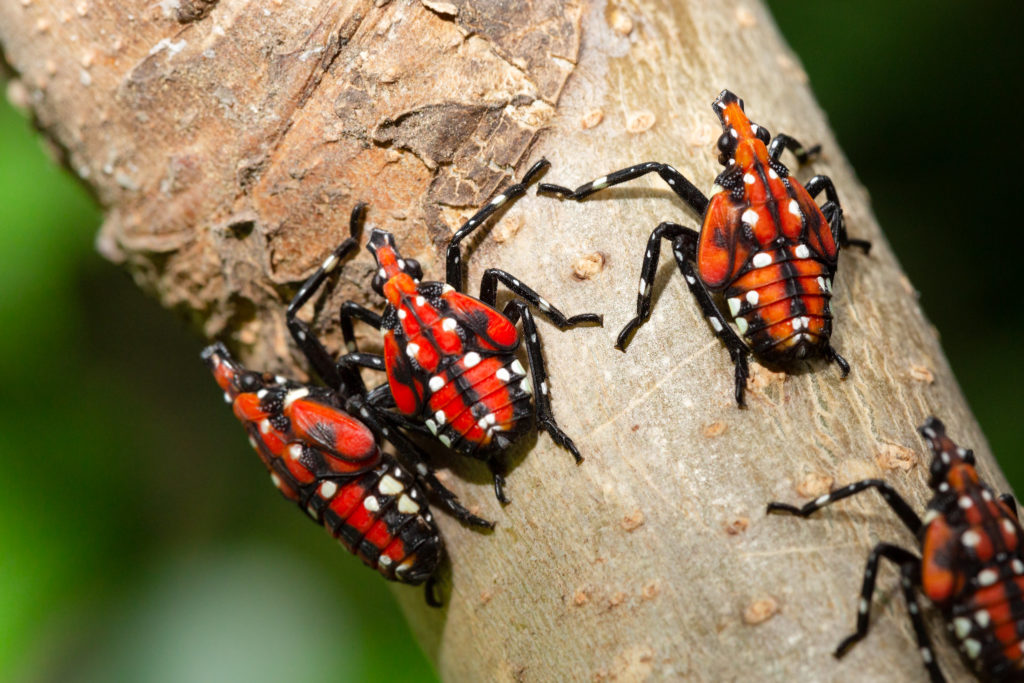New model finds large potential range

The spotted lanternfly (Lycorma delicatula) is an emerging insect pest of a number of economically important crop plants. Originating from China, its primary host plant is tree of heaven (Ailanthus altissima), which is itself considered to be a noxious invasive species in some areas of the United States. The spotted lanternfly damages the leaves and stems of its host plant, and has been recorded on a number of fruit and timber tree species. This species has been identified as a potential pest of grapes, apricots, apples and cherries, among other fruit and timber species of economic significance.
Limited information is currently available on the potential distribution of this species. Forecasting the spread of invasive crop pests is important in order to inform risk assessment, surveying and control measures. Researchers at the United States Department of Agriculture, led by Tewodros T. Wakie, have carried out a study on the current known distribution of the spotted lanternfly, comparing the climate data in its current range with global climate data using a model called MAXENT, which was developed specifically for predicting species distributions.
The results of the study, published in the Journal of Economic Entomology, indicate that climatic conditions are suitable for spotted lanternfly colonisation across large areas of Europe, Asia, Oceania, South America and North America, but that tropical habitats are not suitable to support this species, which differs from previous predictive distribution models.
The spotted lanternfly is still mostly limited to Asia, although it has already made its way to other areas of the world including areas of the United States such as Pennsylvania, where it has rapidly become a serious pest and resulted in local authorities establishing a quarantine zone. These results indicate that this species could become established in a large number of areas that support agricultural activities of high economic significance.
Areas of particular concern identified by the researchers include Spain, France, Italy, Portugal and Romania, which represent the top five grape growing countries in Europe. Further concerns were raised about a number of western states, including Washington, California and Oregon, where the total production value of apples, hops, cherries, grapes and pears exceeded $10 billion dollars in 2018. The potential economic impact of the spotted lanternfly becoming established in these areas could therefore be devastating. The researchers recommend that preventative measures are implemented in countries that are highlighted as having high climatic suitability for this species, and that consideration is given to ensuring early detection through surveying and trapping to ensure that any initial colonisation by this species does not go unnoticed.

In some areas of the United States, the tree of heaven is considered to be an invasive noxious weed, and has become highly abundant throughout states such as Washington and Oregon since its earliest record in 1929. Its prevalence within these states, which have been identified by the model as having a highly suitable climate for the spotted lanternfly, is considered to increase the risk of the spotted lanternfly becoming established in the event that it is introduced to these areas. The researchers therefore recommend that the biosecurity measures implemented to minimise the risk of the spread of this species include control of the tree of heaven to reduce the host plant opportunities available to them.
While the results appear to paint a bleak picture, this research presents information about the possible spread of this species as a form of ‘early warning’, and can therefore be used to inform risk-assessment and prevention strategies in countries that may be affected in the future. The researchers recommend that the model is continuously updated with new climate and species distribution information, and that countries be proactive in implementing prevention and control measures for this species before it develops established populations elsewhere in the world.
Read the full article here: Wakie, T., Neven, L., Yee, W. & Lu, Z. (2019) The establishment risk of Lycorma delicatula (Hemiptera: Fulgoridae) in the United States and globally. Journal of Economic Entomology (published online 03 October 2019). https://doi.org/10.1093/jee/toz259
Find similar articles on CABI’s Horticultural Sciences database.
CABI is investigating the natural enemies of spotted lanternfly in China, particularly their host specificity and population level impact. View the project page: Proactive biocontrol of Spotted Lanternfly
Further reading
- Discovery of three kairomones in relation to trap and lure development for spotted lanternfly (Hemiptera: Fulgoridae)
- Cyclic behavior of Lycorma delicatula (Insecta: Hemiptera: Fulgoridae) on host plants
- Ceroplastes cirripediformis Comstock: a new invasive pest in China (Hemiptera: Coccormorpha: Coccidae)
- Seasonal distribution and movement of the invasive pest Delottococcus aberiae (Hemiptera: Pseudococcidae) within citrus tree: implications for its integrated management
- Invasion of rugose spiraling whitefly, Aleurodicus rugioperculatus Martin (Hemiptera: Aleyrodidae): a potential threat to coconut in India
- Phenacoccus madeirensis Green (Hemiptera: Pseudococcidae): new geographic records and rapid identification using a species-specific PCR assay
- Predicting the potential distributions of the invasive cycad scale Aulacaspis yasumatsui (Hemiptera: Diaspididae) under different climate change scenarios and the implications for management
- A new species of Anastatus (Hymenoptera: Eulpelmidae) from China, parasitizing eggs of Lycorma delicatula (Homoptera: Fulgoridae)
6 Comments
Leave a Reply
Related News & Blogs
5 invasive species to look out for in the US
The presence of invasive species poses a significant hazard to many native environments and species found in the United States (US). They lead to significant expenses in agriculture, forestry, and recreation. Once out of control, they can destroy entir…
26 February 2024





Are they harmful to humans?
Hello – no it is not harmful to humans.
Well after setting up in a tree, the sap draws wasps and bees ALOT. So if you are allergic be aware.
[…] also the article ‘Predicting the spread of invasive spotted lanternfly’ on the Invasives […]
Vinegar is not killing them, just makes them fly away
These things are in my backyard. I live in Queens, NY. 11413. There was 1 on my car and i was in another borough last night.